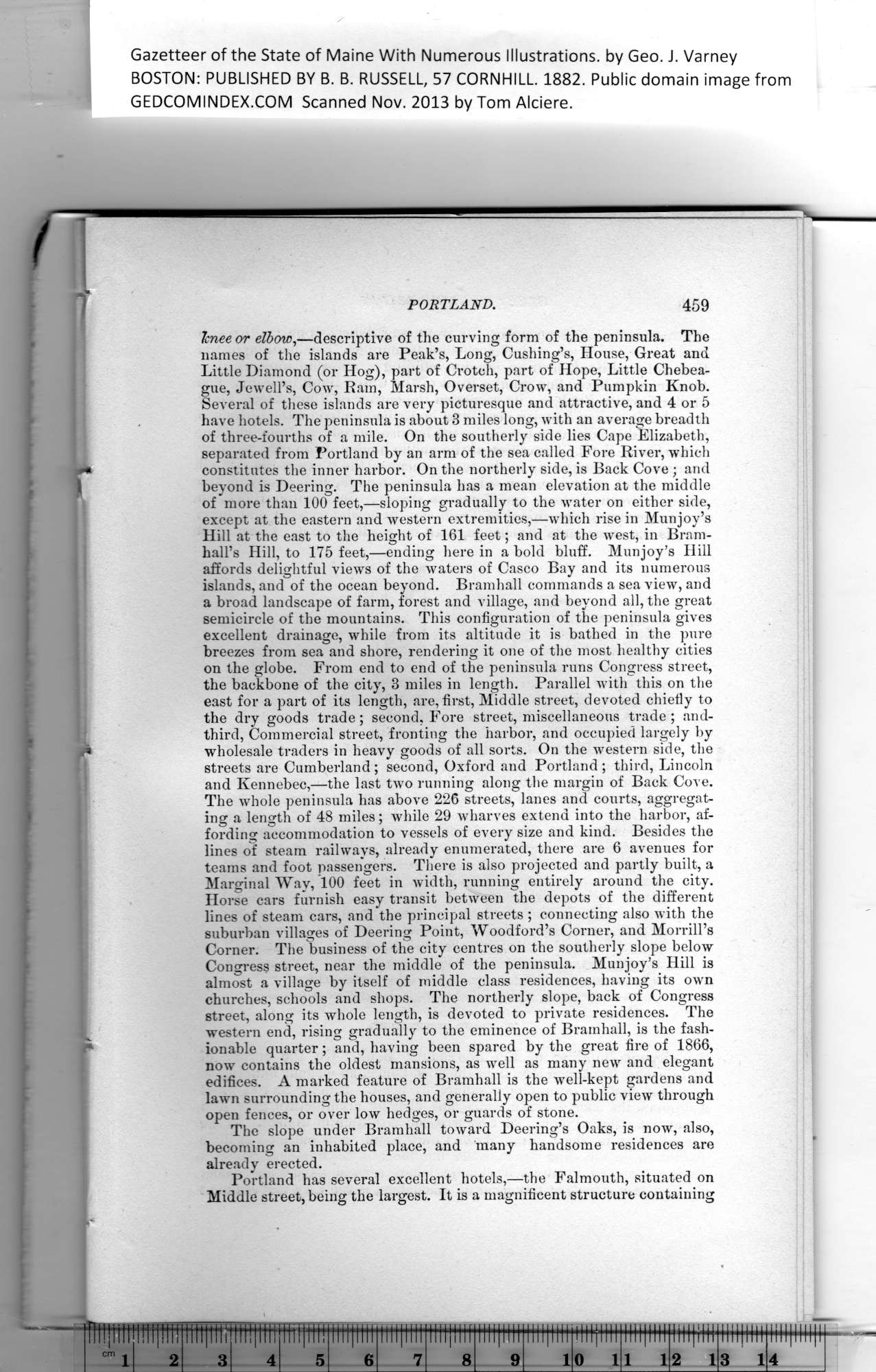|
Gazetteer of the State of Maine With Numerous Illustrations, by Geo. J. Varney
BOSTON: PUBLISHED BY B. B. RUSSELL, 57 CORNHILL. 1882. Public domain image from
PORTLAND. 459
Jcnee or elbow,—descriptive of the curving form of the peninsula. The
names of the islands are Peak’s, Long, Cushing’s, House, Great and
Little Diamond (or Hog), part of Crotch, part of Hope, Little Chebea-
gue, Jewell’s, Cow, Ram, Marsh, Overset, Crow, and Pumpkin Knob.
Several of these islands are very picturesque and attractive, and 4 or 5
have hotels. The peninsula is about 3 miles long, with an average breadth
of three-fourths of a mile. On the southerly side lies Cape Elizabeth,
separated from Portland by an arm of the sea called Fore River, which
constitutes the inner harbor. On the northerly side, is Back Cove ; and
beyond is Deering. The peninsula has a mean elevation at the middle
of more than 100 feet,—sioping gradually to the water on either side,
except at the eastern and western extremities,—which rise in Munjoy’s
Hill at the east to the height of 161 feet; and at the west, in Bram-
hall’s Hill, to 175 feet,—ending here in a bold bluff. Munjoy’s Hill
affords delightful views of the waters of Casco Bay and its numerous
islands, and of the ocean beyond. Bramhall commands a sea view, and
a broad landscape of farm, forest and village, and beyond all, the great
semicircle of the mountains. This configuration of the peninsula gives
excellent drainage, while from its altitude it is bathed in the pure
breezes from sea and shore, rendering it one of the most healthy cities
on the globe. From end to end of the peninsula runs Congress street,
the backbone of the city, 3 miles in length. Parallel with this on the
east for a part of its length, are, first, Middle street, devoted chiefly to
the dry goods trade; second. Fore street, miscellaneous trade; and-
third, Commercial street, fronting the harbor, and occupied largely by
wholesale traders in heavy goods of all sorts. On the western side, the
streets are Cumberland; second, Oxford and Portland; third, Lincoln
and Kennebec,—the last two running along the margin of Back Cove.
The whole peninsula has above 226 streets, lanes and courts, aggregat-
ing a length of 48 miles; while 29 wharves extend into the harbor, af-
fording accommodation to vessels of every size and kind. Besides the
lines of steam railways, already enumerated, there are 6 avenues for
teams and foot passengers. There is also projected and partly built, a
Marginal Way, 100 feet in width, running entirely around the city.
Horse cars furnish easy transit between the depots of the different
lines of steam cars, and the principal streets ; connecting also with the
suburban villages of Deering Point, Woodford’s Corner, and Morrill’s
Corner. The business of the city centres on the southerly slope below
Congress street, near the middle of the peninsula. Munjoy’s Hill is
almost a village by itself of middle class residences, having its own
churches, schools and shops. The northerly slope, back of Congress
street, along its whole length, is devoted to private residences. The
^ western end, rising gradually to the eminence of Bramhall, is the fash-
ionable quarter; and, having been spared hy the great fire of 1866,
i now contains the oldest mansions, as well as many new and elegant
edifices. A marked feature of Bramhall is the well-kept gardens and
lawn surrounding the houses, and generally open to public view through
open fences, or over low hedges, or guards of stone.
The slope under Bramhall toward Deering’s Oaks, is now, also,
becoming an inhabited place, and many handsome residences are
already erected.
Portland has several excellent hotels,—the Falmouth, situated on
Middle street, being the largest. It is a magnificent structure containing
PREVIOUS PAGE ... NEXT PAGE
This page was written in HTML using a program written in Python 3.2
|
